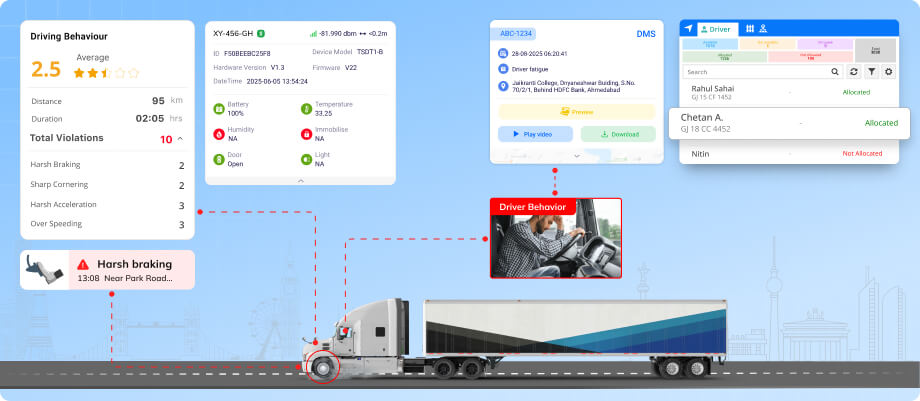In countries such as the UK and Germany, fleet operators face some of the strict compliance and safety standards in Europe. From London’s Direct Vision Standard (DVS) to Germany’s strict tachograph enforcement, regulations are evolving rapidly. This is concerned with ensuring road safety, environmental protection, and driver welfare. But for many transporters and logistics companies, manually tracking compliance or identifying safety risks across vehicles is difficult. Fleet management software is now playing a vital role in helping businesses remain compliant while ensuring that both vehicles and drivers perform safely and efficiently.
Fleet compliance and safety monitoring in Europe’s high-regulation zones
Introduction
Challenges
- Inconsistent compliance with regional mandates: Whether it’s DVS in the UK or tachograph data in Germany, fleets often operate without real-time visibility into their compliance status. Missing even a single requirement can lead to heavy penalties or restricted access in regulated zones.
- Unmonitored unsafe driving behavior: Fleet managers often lack tools to detect real-time incidents like harsh braking, speeding, or fatigue-related risks. Without this visibility, unsafe behavior continues unchecked, increasing the risk of accidents and insurance claims.
- Manual or delayed vehicle inspections: Vehicle walkaround checks and daily inspection reports are often done on paper or not completed at all. This creates compliance gaps and delays in identifying critical safety issues.
- Difficulty in evaluating driver performance fairly: Without a standardized system, tracking which drivers consistently follow rules, complete DVIRs, and maintain safe driving habits becomes difficult. This impacts training, reward, and accountability programs.
Solution
- Real-time driver behavior monitoring: Detects events like over-speeding, harsh acceleration, and prolonged idling. Enables fleet managers to take immediate action, reducing accident risks and improving fuel efficiency.
- DVIR and digital inspection management: Allows drivers to complete daily vehicle checks through a mobile app. Issues are reported instantly, helping maintain vehicle safety standards and reducing downtime.
- Driver scorecards and reports: Ranks drivers based on adherence to safety rules, DVIR completion, and behavior trends. Helps identify top performers and those needing support or retraining.
- Vehicle health monitoring: Tracks critical parameters like engine hours, coolant levels, battery voltage, and more. Sends alerts when faults are detected, supporting timely maintenance and reducing roadside breakdowns.
- Tachograph integration and regional compliance tools: Enables automatic collection and reporting of driver work/rest hours. Ensures businesses stay compliant with EU driving hour regulations and avoid fines.
Results
- Fewer driving violations and safety risks: With real-time monitoring and driver scorecards in place, many fleet operators in the UK and Germany observed a sharp decline in unsafe driving behaviors. Fleets reported fewer speeding events, harsh braking incidents, and accident-related downtime.
- Higher vehicle inspection compliance: Digital DVIR tools improved daily inspection routines, making it easier for drivers to submit accurate reports. This led to quicker identification of vehicle issues and enhanced overall fleet safety and roadworthiness.
- Reduction in regulatory fines and access restrictions: By using automated compliance tools for tachograph data and regional mandates, fleets were able to operate more confidently in regulated areas. Businesses experienced fewer penalties and smoother access through zones with DVS and emission rules.




